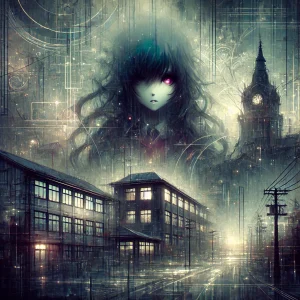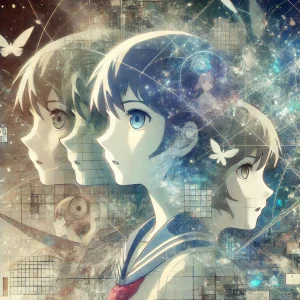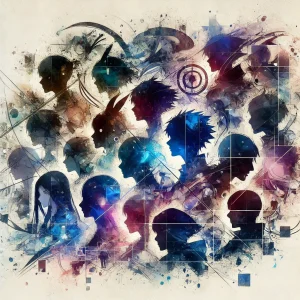Introduction to Boogiepop and Others

Hey there! Have you ever heard of "Boogiepop and Others"? If not, you're in for a treat. This anime series, based on Kouhei Kadono's original light novel series, has captivated audiences with its unique storytelling and eerie atmosphere.
"Boogiepop and Others" isn't your typical anime. It dives deep into themes of fear, identity, and the unknown. The story revolves around a mysterious entity known as Boogiepop, who appears when there's a threat to humanity. The narrative is non-linear, jumping between different characters' perspectives, which keeps you on your toes.
Kouhei Kadono's light novels set the stage for this mind-bending series. Originally published in 1998, the novels quickly gained a cult following. Kadono's writing is both poetic and unsettling, blending everyday high school life with supernatural horrors. The anime adaptation captures this essence beautifully, making it a must-watch for fans of psychological thrillers.
One of the fascinating aspects of "Boogiepop and Others" is its tone. It's dark and atmospheric, creating a sense of unease that lingers long after you've finished watching. The characters are complex, each with their own secrets and motivations. Boogiepop, in particular, is an enigmatic figure – is he a hero, a villain, or something else entirely?
The themes explored in the series are profound and thought-provoking. Fear is a constant presence, not just in the form of monsters, but also in the characters' inner struggles. Identity is another key theme, as characters grapple with their true selves and the masks they wear. The unknown looms large, with mysteries that unravel slowly, drawing you deeper into the story.
Plot Overview

Hey, have you heard the story of "Boogiepop and Others"? It's a bit of a brain-twister, but that's what makes it so fascinating. The central storyline revolves around Boogiepop, a mysterious entity that emerges when danger threatens the world. But don’t be fooled; this isn’t a straightforward hero tale.
The plot kicks off with strange disappearances at Shinyo Academy. Students vanish without a trace, causing panic and rumors. Enter Boogiepop, the enigmatic figure who supposedly appears to combat these supernatural threats. But here’s the twist: Boogiepop isn’t the only one in the spotlight. The story unfolds through the eyes of various characters, each with their own piece of the puzzle.
One of the key events is the appearance of the Towa Organization, a shadowy group conducting experiments to control human evolution. Their creation, Echoes, a being from another dimension, becomes central to the conflict. Echoes is on a mission to stop the Towa Organization's inhumane practices, but he's being hunted down. This clash sets the stage for some intense moments.
Another significant twist involves the characters' dual identities. For instance, Touka Miyashita, a seemingly ordinary schoolgirl, is actually the vessel for Boogiepop. This duality adds layers to the narrative, making you question who’s who and what’s real.
Now, let's talk about the narrative structure. Unlike traditional storytelling, "Boogiepop and Others" adopts a non-linear approach. The plot is fragmented, jumping back and forth in time and between different viewpoints. At first, it might seem disjointed, but this method allows the mystery to unravel gradually. You piece together the story bit by bit, like a jigsaw puzzle, which is incredibly satisfying.
Characters such as Nagi Kirima, also known as the Fire Witch, play pivotal roles. She’s determined to uncover the truth behind the disappearances and the Towa Organization. Her encounters with Boogiepop and Echoes are intense and reveal deeper connections between the characters.
Character Profiles

Hey there! Let’s dive into the fascinating characters of "Boogiepop and Others." They’re what really bring the story to life, with each one adding their own unique twist to the tale.
First up, we have Boogiepop. Boogiepop is an enigmatic figure, often described as the "angel of death." But don’t be misled by that ominous title. Boogiepop appears when danger looms, acting as a protector against supernatural threats. What’s intriguing is that Boogiepop isn’t a standalone entity. Instead, this mysterious character emerges from Touka Miyashita, a seemingly ordinary high school girl. This duality creates a captivating dynamic. One moment, Touka is living her normal teenage life; the next, Boogiepop takes over, driven by an instinct to eliminate evil.
Speaking of Touka Miyashita, she’s the vessel for Boogiepop. Touka is your typical student, or so it seems. She’s quiet, unassuming, and blends into the background. But when Boogiepop surfaces, her entire demeanor changes. This transformation is crucial to the story, as it reveals the hidden depths within Touka. It also raises questions about her awareness and control over Boogiepop’s actions. Is she just a passive host, or does she play a more active role in the supernatural battles?
Next, we have Nagi Kirima, also known as the Fire Witch. Nagi is a strong-willed and determined character, dedicated to uncovering the truth behind the mysterious disappearances at Shinyo Academy. She’s skeptical of the official explanations and takes matters into her own hands. Nagi’s encounters with Boogiepop are intense, as they both seek to uncover and combat the sinister forces at play. Throughout the series, Nagi’s character develops from a solitary investigator to someone who realizes the importance of alliances in battling evil.
Echoes, another pivotal character, adds to the complexity. Echoes is an extraterrestrial being on a mission to stop the Towa Organization’s unethical experiments. His presence introduces a broader scope to the conflict, highlighting the interdimensional stakes at play. Echoes’ interactions with other characters, particularly Nagi and Boogiepop, are essential in unveiling the true extent of the threats facing humanity.
We also have the Towa Organization, a shadowy group whose members are shrouded in secrecy. Their experiments on human evolution are central to the plot, and their motives add a layer of intrigue. Characters associated with the Towa Organization, such as Spooky E, bring a sinister edge to the story. Spooky E, with his ability to manipulate others, represents the pervasive and insidious nature of the organization’s influence.
These characters aren’t just static figures; they evolve throughout the series. Their development is driven by their encounters with the unknown and their struggles to understand and combat the threats they face. The interplay between their personal growth and the overarching plot is what makes "Boogiepop and Others" so compelling.
Themes and Motifs

Hey, ready to dive into the deep stuff? "Boogiepop and Others" isn’t just an anime with a cool plot and interesting characters. It’s rich with themes and motifs that make you think and feel on a whole other level.
Let’s start with fear. Fear is a central theme in "Boogiepop and Others," but it’s not just about being scared of monsters or supernatural entities. The fear in this series is more existential. It’s about the fear of the unknown, the fear of losing one’s identity, and the fear of what lies beneath the surface of everyday life. This pervasive sense of dread keeps you on edge, making the story all the more compelling.
Then there’s identity. This theme is intricately woven into the fabric of the series. Characters grapple with who they are and who they are perceived to be. Take Boogiepop, for instance. Is Boogiepop a separate entity, or just another facet of Touka Miyashita? This duality raises questions about the nature of self and the masks we wear. Each character’s struggle with identity adds depth to the narrative, making their journeys resonate on a personal level.
Existentialism is another biggie. The series often delves into philosophical questions about the meaning of life and the nature of existence. Characters like Echoes, who come from another dimension, force us to think about our place in the universe. These existential themes aren’t just background noise; they’re central to the story, influencing characters’ actions and the plot’s direction.
Motifs and symbolism are also abundant. One recurring motif is the butterfly. Butterflies in "Boogiepop and Others" symbolize transformation and the fleeting nature of life. They often appear during critical moments, emphasizing the changes characters undergo and the transient beauty of their experiences. Another symbol is the light and darkness, representing knowledge and ignorance, safety and danger. These visual cues add layers of meaning to the narrative.
So, how do these elements contribute to the overall story? Well, they make "Boogiepop and Others" more than just a supernatural mystery. The themes of fear, identity, and existentialism give the story emotional weight, making the characters' struggles feel real and significant. The motifs and symbolism enrich the visual storytelling, making every scene packed with meaning.
These elements ensure that "Boogiepop and Others" isn’t just a show you watch; it’s a show you experience and reflect upon. It sticks with you, long after the final credits roll, making you ponder the big questions about life, identity, and what it means to truly understand oneself and the world.
Reception and Impact

Hey, let's talk about the reception and impact of "Boogiepop and Others." This series has left quite a mark both in Japan and internationally. When it first aired, it received a mix of reactions. Some viewers were immediately captivated by its dark, mysterious tone and non-linear storytelling. Others found it a bit challenging to follow. But that’s part of what makes "Boogiepop and Others" so intriguing—it doesn’t spoon-feed you the plot; you have to piece it together yourself.
In Japan, the series was praised for staying true to Kouhei Kadono’s original light novels. Fans appreciated the detailed character development and the way the anime handled complex themes like fear and identity. The unique narrative style was a bold move that set it apart from other series at the time. Critics highlighted its atmospheric tension and thought-provoking story, although some noted it could be confusing for viewers not familiar with the source material.
Internationally, "Boogiepop and Others" garnered a cult following. Anime enthusiasts outside Japan were drawn to its psychological depth and unconventional storytelling. It was a breath of fresh air for those tired of formulaic anime plots. The series' release coincided with a growing interest in anime worldwide, helping to cement its status as a must-watch for serious fans. Reviews often pointed out its philosophical undertones and complex characters as standout features.
Now, let’s talk influence. "Boogiepop and Others" has had a significant impact on the anime genre. Its success opened doors for more experimental and avant-garde anime series. Shows that followed didn’t shy away from non-linear narratives or deep, existential themes, thanks in part to the groundwork laid by "Boogiepop." The series proved that there was a market for anime that challenged viewers intellectually and emotionally.
The legacy of "Boogiepop and Others" is still felt today. It's considered a classic, often recommended to new anime fans looking to explore the genre’s more cerebral side. Its influence is evident in many subsequent works that embrace a similar style and thematic complexity. The characters, especially Boogiepop, have become iconic, representing a break from traditional hero archetypes in anime.
Continued relevance? Absolutely. "Boogiepop and Others" remains a touchstone for discussions about innovative storytelling in anime. Its themes of fear and identity are timeless, resonating with new generations of viewers. The series is often revisited by fans and critics alike, who find new layers of meaning with each watch. It's a testament to the enduring power of a well-crafted story that challenges and engages its audience.
So, if you’re diving into "Boogiepop and Others," know that you’re exploring a piece of anime history. Its reception might have been mixed initially, but its impact and legacy are undeniably profound, shaping the landscape of anime in ways that continue to inspire and influence today.
